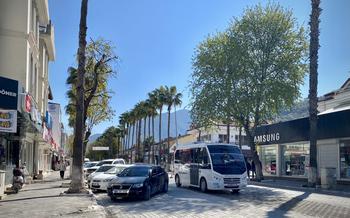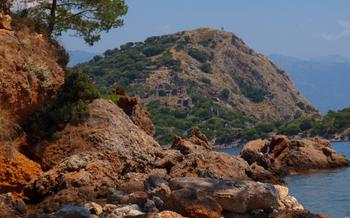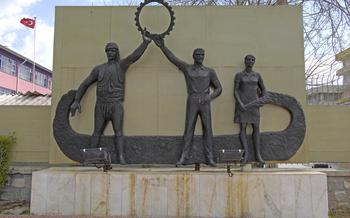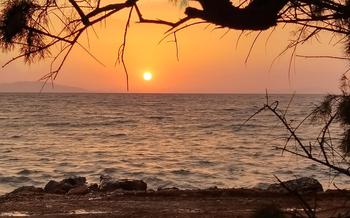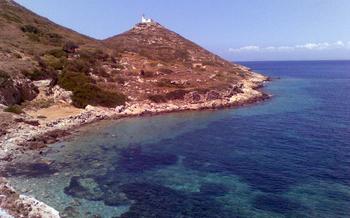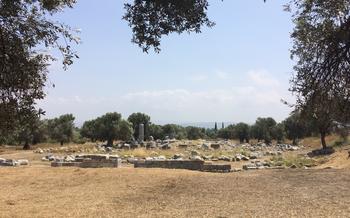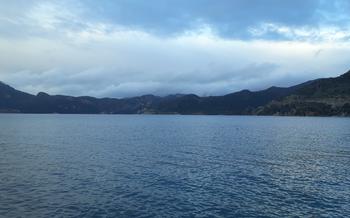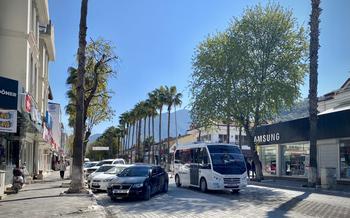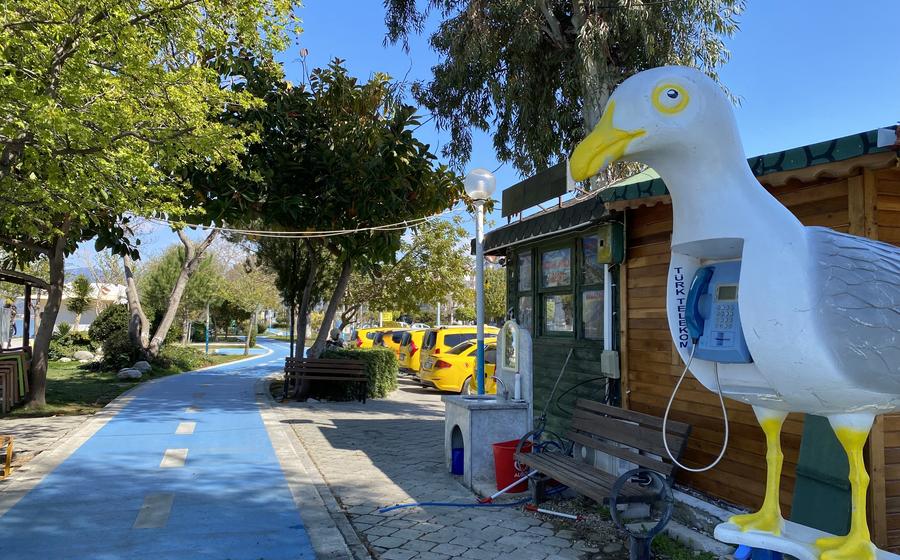
Loryma Ancient City
- The Antiquity of Loryma
- Loryma's Geographical Setting
- Exploring the Ruins of Loryma
- The Agora and Public Spaces
- Religious Sites and Temples
- The Temple of Apollo
- Other Temples and Deities
- Discoveries and Inscriptions
- Significance of the Temples
- The Necropolis and Burial Customs
- Loryma's Maritime Heritage
- The Museum of Loryma
- Local Festivals and Events
- Gastronomic Delights
- Outdoor Activities
- Accommodation and Amenities
- Best Time to Visit
- Transportation and Accessibility
- Insider Tip: Unveiling Loryma's Hidden Charms
The Antiquity of Loryma
Loryma, an ancient city nestled on the Gulf of Gökova, boasts a rich historical tapestry that spans multiple civilizations. Its origins can be traced back to the Hellenistic period, where it flourished as a significant port city. The city's strategic location allowed it to thrive as a trading hub, connecting the Aegean and Mediterranean regions.
During the Roman era, Loryma continued to prosper, becoming a prominent municipality within the Roman province of Asia. The city embraced Roman culture and architecture, evidenced by the impressive remains of its theater, odeon, and other public structures.
In the Byzantine period, Loryma underwent a transformation, becoming a center of Christianity. The city's churches and religious monuments, though now in ruins, testify to its significance as a spiritual and ecclesiastical center.
Archaeological excavations conducted in Loryma have unearthed a wealth of artifacts, shedding light on its vibrant past. Discoveries include ceramics, sculptures, inscriptions, and architectural fragments, providing valuable insights into the city's daily life, trade, and cultural practices.
Loryma's Geographical Setting
Loryma's strategic location on the Gulf of Gökova, an inlet of the Aegean Sea, played a crucial role in its development and significance. The city commanded a panoramic view of the gulf, allowing its inhabitants to monitor and control maritime traffic. Its natural surroundings, with lush green hills and sparkling turquoise waters, added to its allure.
Loryma's proximity to other historical sites and tourist attractions further enhanced its appeal. The ancient city of Knidos, renowned for its stunning temple of Aphrodite, lies just across the gulf, offering visitors a chance to explore two remarkable cities in one trip. The picturesque town of Datça, with its charming harbor and scenic coves, is also within easy reach, providing a delightful contrast to the historical ruins.
Exploring the Ruins of Loryma
As you wander through the ruins of Loryma, you'll encounter remnants of its once-mighty fortifications, including sturdy city walls and imposing gates. These structures, bearing the marks of time, provide a glimpse into the city's resilience and strategic importance.
At the heart of Loryma lies its well-preserved theater, an architectural marvel that has withstood the test of centuries. Step into this ancient auditorium and imagine the lively performances, theatrical dramas, and civic gatherings that once took place here. The theater's intricate carvings, acoustics, and seating arrangements offer a captivating glimpse into Loryma's cultural heritage.
Adjacent to the theater is the Odeon, a smaller venue likely used for musical performances, lectures, and recitals. Its well-preserved stage and seating suggest the vibrant artistic and intellectual life that thrived within Loryma's walls.
The Agora and Public Spaces
At the heart of Loryma, the agora served as the city's central square, a bustling hub of civic and commercial activities. This expansive space was lined with restored shops, known as stoas, where merchants displayed their wares and conducted business. The agora also housed various public buildings, including administrative offices and meeting halls, where citizens gathered to discuss important matters affecting their community.
Beyond its commercial significance, the agora served as a vital social and cultural center. Here, locals and visitors alike exchanged news, shared stories, and engaged in lively debates. It was a place where people from all walks of life came together to forge connections and foster a sense of community.
As you explore the agora, take note of the well-preserved architectural details that adorn the stoas and public buildings. Intricate carvings, decorative columns, and mosaic floors speak to the artistry and craftsmanship of Loryma's ancient inhabitants. Imagine the vibrant atmosphere that once filled this space, with the hustle and bustle of trade, the hum of conversations, and the laughter of friends meeting in the heart of their city.
Religious Sites and Temples
Among the ruins of Loryma, the remnants of several temples dedicated to various deities stand as testaments to the city's rich religious history. These sacred structures offer a glimpse into the spiritual beliefs and practices of the ancient inhabitants.
The Temple of Apollo
The most prominent of these temples is the Temple of Apollo, situated on a hilltop overlooking the city. This sanctuary was dedicated to the Greek god Apollo, who was revered as the patron deity of Loryma. According to legend, an oracle was associated with the temple, where people sought divine guidance and prophecies.
Other Temples and Deities
In addition to the Temple of Apollo, archaeological excavations have revealed the remains of temples dedicated to other deities, including Zeus, Athena, and Aphrodite. These temples served as centers of worship and religious ceremonies, reflecting the diverse pantheon of gods and goddesses worshipped by the ancient Lorymians.
Discoveries and Inscriptions
During excavations, archaeologists have unearthed a wealth of religious artifacts, such as statues, altars, and inscriptions. These discoveries provide valuable insights into the religious practices and rituals performed within the temples. Inscriptions found at the site have shed light on the names of deities, religious festivals, and the roles of priests and priestesses.
Significance of the Temples
The religious sites of Loryma offer a glimpse into the spiritual lives of the ancient inhabitants. They showcase the importance of religion in shaping the community's beliefs, values, and traditions. The temples also serve as reminders of the cultural and religious diversity that characterized the ancient world.
The Necropolis and Burial Customs
Beyond the city walls, an extensive cemetery area invites exploration. Here, visitors can delve into the funerary customs and beliefs of ancient Loryma. A variety of tombs, ranging from simple graves to elaborate mausoleums, offer a glimpse into the lives and deaths of the city's inhabitants. The necropolis provides a poignant reminder of the rich cultural heritage that permeates this ancient site.
The diversity of tombs reflects the social stratification that existed within Loryma. While some individuals were buried in simple pits or cist graves, others were laid to rest in grand mausoleums adorned with intricate carvings and inscriptions. These elaborate tombs often contained grave goods such as jewelry, pottery, and personal items, which provide valuable insights into the material culture and beliefs of the Lorymans.
The presence of both cremation and inhumation burials suggests that different funerary practices coexisted in Loryma. Cremation was a common practice among the Greeks and Romans, while inhumation was more prevalent among the indigenous Carian population. The discovery of both types of burials within the same necropolis highlights the cultural diversity that characterized this ancient city.
Loryma's Maritime Heritage
Loryma's strategic location on the Gulf of Gökova made it a natural hub for maritime trade and commerce in ancient times. The city's harbor, sheltered by a natural bay, provided a safe haven for ships sailing the Aegean Sea. The remains of shipyards and docks can still be seen along the shoreline, attesting to the city's once-thriving maritime industry.
As a maritime center, Loryma played a crucial role in the exchange of goods, ideas, and cultural influences between different civilizations. Ships from across the Mediterranean docked at its harbor, bringing with them a diverse array of products and cultural influences from Greece, Egypt, and other parts of the ancient world. Loryma's strategic position also made it an important stop on trade routes between the Anatolian mainland and the Aegean islands.
The city's maritime heritage is further evidenced by the discovery of numerous shipwrecks in the waters surrounding Loryma. These shipwrecks, which range from ancient trading vessels to later Byzantine ships, provide valuable insights into the maritime activities and trade networks of the region.
The Museum of Loryma
Within the Loryma Ancient City, a treasure trove of history and culture awaits visitors at the on-site museum. This esteemed institution houses a captivating collection of artifacts unearthed from the city's rich past, offering a glimpse into the lives and traditions of its ancient inhabitants.
As you step inside the museum, you'll be greeted by an array of keramik pieces, each intricately designed and painted, showcasing the artistic prowess of Loryma's artisans. Sculptures of gods, goddesses, and mythological creatures stand proudly, capturing the essence of the city's religious beliefs and mythology. Other relics, such as coins, tools, and jewelry, provide tangible evidence of everyday life in Loryma, shedding light on the city's economy, trade, and social customs.
The museum's exhibits are thoughtfully curated, providing historical context and explanations for each artifact. Interactive displays and multimedia presentations bring Loryma's story to life, allowing visitors to immerse themselves in the city's past. Whether you're a history buff, an archaeology enthusiast, or simply curious about ancient civilizations, the Museum of Loryma is an essential stop on your journey through this historic city.
Local Festivals and Events
Loryma and the surrounding region come alive during various traditional Turkish festivals and events, offering visitors a chance to experience the vibrant local culture and traditions. These events showcase the rich heritage of the region and provide a glimpse into the daily lives of its people.
For history enthusiasts, the annual Loryma Festival takes place within the ancient city, featuring reenactments of historical events, traditional performances, and exhibitions showcasing the city's rich past. Immerse yourself in the atmosphere of ancient Loryma as you witness processions, theatrical performances, and demonstrations of traditional crafts.
Throughout the year, various cultural and artistic events are held in the region, showcasing local music, dance, and folklore. Don't miss the opportunity to attend a traditional Turkish night, where you can indulge in delicious food, listen to enchanting music, and witness captivating dance performances.
For those seeking a more active experience, the Loryma Marathon is a popular event that draws participants from around the world. This annual event offers a unique opportunity to run through the ancient city and its surroundings, immersing yourself in the picturesque landscapes and historical sites.
Whether you're interested in history, culture, or sports, Loryma and its region offer a range of festivals and events that cater to diverse interests. Make sure to check the local calendar during your visit to ensure you don't miss out on these vibrant celebrations.
Gastronomic Delights
A trip to Turkey, and specifically to Loryma, would be incomplete without savoring the delectable flavors of Turkish cuisine. The region offers a diverse range of culinary experiences, from traditional dishes to modern interpretations. Local restaurants and cafes, often nestled within charming historical settings, serve up an array of tantalizing dishes that reflect the country's rich culinary heritage.
Indulge in the succulent flavors of grilled meats, such as kebabs and döner, or savor the aromatic delights of Turkish meze platters, featuring an assortment of small dishes like hummus, baba ghanoush, and stuffed grape leaves. Vegetarians will find plenty of options, with dishes like gözleme (savory pancakes filled with spinach, cheese, or minced meat) and vegetable stews.
For a truly unforgettable experience, dine at a restaurant overlooking the ancient city walls or the serene waterfront. Imagine savoring a traditional Turkish breakfast of fresh bread, olives, cheese, and honey while taking in the panoramic views of Loryma's ruins. As the sun sets, enjoy a leisurely dinner accompanied by the gentle sounds of traditional Turkish music.
Don't forget to try the region's famous sweets, such as Turkish delight and baklava, which offer a delightful blend of flavors and textures. These sweet treats, often made with nuts, honey, and filo pastry, are a perfect way to end your culinary journey in Loryma.
Outdoor Activities
For those seeking adventure beyond the ancient ruins, Loryma offers a range of outdoor activities that blend history with nature. Explore the scenic hills surrounding the city through hiking trails that lead to breathtaking views. Trek through the lush landscapes, discovering hidden coves and ancient paths once trodden by the city's inhabitants. The crystal-clear waters of the nearby Aegean Sea invite visitors to dive into history, uncovering sunken treasures and marine life amidst ancient shipwrecks. Snorkeling and diving enthusiasts can immerse themselves in the underwater world, encountering colorful coral reefs and diverse marine species. Whether hiking through time or diving into the depths, Loryma offers a harmonious fusion of history and outdoor adventure.
Accommodation and Amenities
Loryma offers a range of accommodation options to suit different travel styles and budgets. Quaint guesthouses nestled within the charming village provide a cozy and authentic experience. For those seeking a more luxurious stay, boutique hotels offer modern amenities and stunning views of the ancient city and the surrounding landscape.
Essential amenities and facilities are readily available in Loryma to ensure a comfortable stay. Restaurants and cafes serving traditional Turkish cuisine and international fare abound, catering to diverse culinary preferences. Well-stocked grocery stores and markets provide visitors with the option to cook their meals and savor local delicacies in the privacy of their accommodation.
When choosing accommodation in Loryma, consider factors such as proximity to the ancient city, personal preferences, and budget. For a truly immersive experience, opt for a guesthouse or hotel within walking distance of the ruins, allowing for easy exploration and fewer transportation concerns.
Best Time to Visit
Timing is everything, and the same goes for a trip to Loryma. To fully enjoy the allure of this ancient city, the best time to visit is during the shoulder seasons, from April to May and September to October. During these periods, the weather is usually mild and pleasant, with warm days and cool nights. You'll avoid the scorching summer heat while still relishing the outdoor activities and exploration.
While Loryma is beautiful year-round, the summer months (June to August) can be quite hot and crowded with tourists. If you're willing to brave the heat, you'll be rewarded with fewer crowds and more opportunities to soak up the history and ambiance of the site.
For those seeking a truly unique experience, consider visiting during the Loryma Festival, typically held in July. This annual event brings the ancient city to life with theatrical performances, historical reenactments, and traditional music and dance. It's a chance to immerse yourself in Loryma's rich past and witness the vibrant culture of the region.
Transportation and Accessibility
Getting to Loryma is a breeze, with multiple options available to suit your travel preferences.
- By Car:
- Enjoy the scenic drive through the Turkish countryside.
-
Follow signs to "Loryma Antik Kenti" or use a GPS navigation app.
-
By Public Transport:
- Take a bus from Muğla or Marmaris to Datça.
-
From Datça, hop on a local bus or taxi to Loryma.
-
By Organized Tour:
- Join a guided tour from major cities like Bodrum or Fethiye.
- Benefit from expert commentary and hassle-free transportation.
Plan your journey to arrive in the morning or early afternoon to make the most of your visit.
Insider Tip: Unveiling Loryma's Hidden Charms
Beyond the main attractions, Loryma offers hidden gems waiting to be discovered. Venture off the beaten path to uncover the Temple of Athena, a smaller yet equally significant temple dedicated to the goddess of wisdom and warfare. Its well-preserved ruins provide a glimpse into Loryma's religious diversity.
For a unique perspective, embark on a guided kayaking tour along the coastline. Paddle through crystal-clear waters, exploring secluded coves and hidden beaches inaccessible by land. Admire Loryma's ancient walls and fortifications from a different angle, and immerse yourself in the tranquility of nature.
If you're visiting in the summer months, don't miss the Loryma Festival, a vibrant celebration of the city's history and culture. Experience traditional Turkish music, dance, and cuisine, and witness live reenactments of ancient rituals and ceremonies. It's an unforgettable opportunity to delve into the heart of Loryma's past.

